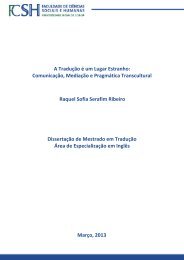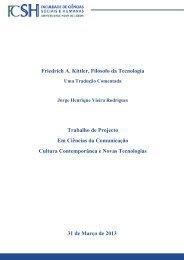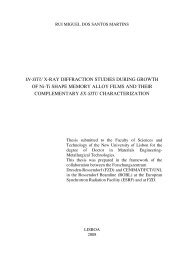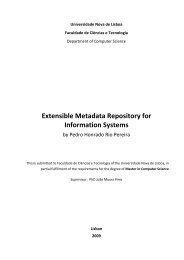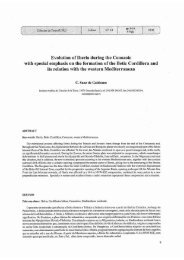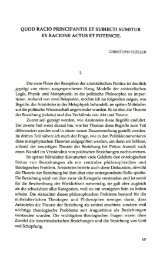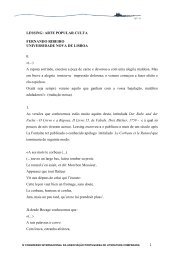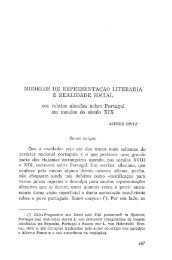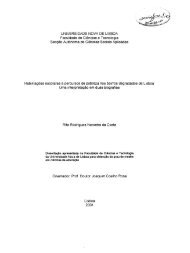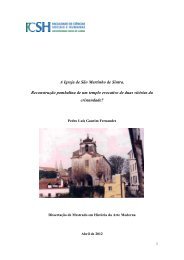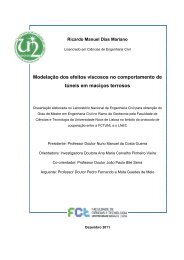Elias Manuel Morgado Pinheiro Dissertação de Mestrado em ...
Elias Manuel Morgado Pinheiro Dissertação de Mestrado em ...
Elias Manuel Morgado Pinheiro Dissertação de Mestrado em ...
You also want an ePaper? Increase the reach of your titles
YUMPU automatically turns print PDFs into web optimized ePapers that Google loves.
RESUMO<br />
Orig<strong>em</strong> e Difusão do Carro <strong>de</strong> Guerra<br />
Uma das mais b<strong>em</strong> sucedidas tecnologias da Ida<strong>de</strong> do Bronze foi o carro <strong>de</strong><br />
guerra. O seu sucesso levou a uma dispersão inaudita através da Ásia. A probl<strong>em</strong>ática<br />
das suas origens é tradicionalmente abordada numa base regional. O presente estudo<br />
preten<strong>de</strong> abordar o assunto <strong>de</strong> um ponto <strong>de</strong> vista trans-regional, focando as ligações<br />
existentes entre diferentes regiões, <strong>de</strong> forma a gerar uma visão mais abrangente do<br />
probl<strong>em</strong>a. Para além disso, procura evi<strong>de</strong>nciar as ligações existentes entre as regiões<br />
mais periféricas, a Índia e a China, e o tradicional núcleo <strong>de</strong> <strong>de</strong>senvolvimento do carro<br />
<strong>de</strong> guerra, a Ásia Oci<strong>de</strong>ntal e as estepes Eurasiáticas.<br />
Consi<strong>de</strong>rando as ligações entre as estepes a sul do Urais e a Ásia Oci<strong>de</strong>ntal, é<br />
possível concluir que os primeiros passos no <strong>de</strong>senvolvimento do carro <strong>de</strong> guerra<br />
ocorreram nas estepes da região <strong>de</strong> Sintashta, c. 2000 BC. Contudo, na Ásia Oci<strong>de</strong>ntal,<br />
essa tecnologia foi mais tar<strong>de</strong> adaptada a mo<strong>de</strong>los autóctones, <strong>de</strong> forma a criar um<br />
veículo melhor equipado para lidar com as necessida<strong>de</strong>s locais. Apesar da existência <strong>de</strong><br />
pequenas adaptações locais, as s<strong>em</strong>elhanças entre os vários mo<strong>de</strong>los <strong>de</strong> carros <strong>de</strong> guerra<br />
permit<strong>em</strong> rejeitar a possibilida<strong>de</strong> <strong>de</strong> um <strong>de</strong>senvolvimento in<strong>de</strong>pen<strong>de</strong>nte <strong>em</strong> diferentes<br />
regiões. De facto, é possível i<strong>de</strong>ntificar uma só tradição referente ao carro <strong>de</strong> guerra ao<br />
longo do continente asiático, da Ásia Oci<strong>de</strong>ntal à China, e das estepes Eurasiáticas à<br />
Índia.<br />
PALAVRAS-CHAVE: carro <strong>de</strong> guerra, estepe, Ásia, Índia, China, orig<strong>em</strong> do carro <strong>de</strong><br />
guerra, difusão do carro <strong>de</strong> guerra, ligações trans-regionais.<br />
Abstract<br />
The Origin and Spread of the War Chariot<br />
One of the most successful Bronze Age technologies was the light war chariot.<br />
Its success meant an unprece<strong>de</strong>nted spread throughout all of Asia. The subject of its<br />
origins is traditionally approached on regional basis. The present work seeks to address<br />
the issue from a trans-regional standpoint, focusing in the connections between different<br />
regions, and thus creating a broa<strong>de</strong>r un<strong>de</strong>rstanding of the probl<strong>em</strong>. Furthermore, it seeks<br />
to highlight the connections between the more peripheral regions, India and China, and<br />
the traditional cluster of <strong>de</strong>velopment of the war chariot, West Asia and the Eurasian<br />
steppes.<br />
Consi<strong>de</strong>ring the connections between the steppes south of the Urals and West<br />
Asia, it is possible to conclu<strong>de</strong> that the first <strong>de</strong>velopments towards the light chariot took<br />
place in the Sintashta region, c. 2000 BC. However, in West Asia, that particular<br />
technology was adapted to native chariot <strong>de</strong>signs, in or<strong>de</strong>r to produce a vehicle better<br />
suited to specific regional needs. Despite minor local adaptations, the similarities<br />
between all chariots‟ <strong>de</strong>signs discard the possibility of in<strong>de</strong>pen<strong>de</strong>nt <strong>de</strong>velopment in<br />
different regions. In fact, a single and continuous chariot tradition can be seen<br />
throughout the continent, from West Asia to China, from the Eurasian steppes to India.<br />
KEY-WORDS: war-chariot, steppe, Asia, India, China, origin of the war chariot, spread<br />
of the war chariot, trans-regional connections<br />
iii



